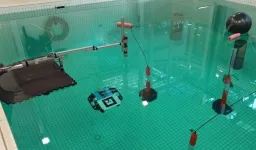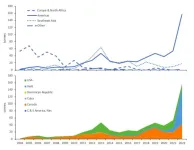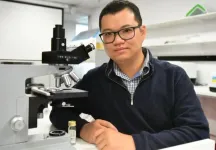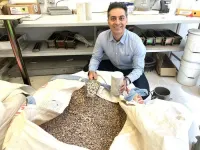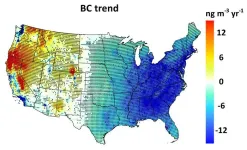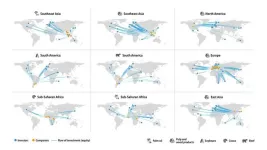Using AI to find microplastics
Researchers use AI to identify toxic substances in wastewater with greater accuracy and speed
2023-12-05
(Press-News.org)
An interdisciplinary research team from the University of Waterloo is using artificial intelligence (AI) to identify microplastics faster and more accurately than ever before.
Microplastics are commonly found in food and are dangerous pollutants that cause severe environmental damage – finding them is the key to getting rid of them.
The research team’s advanced imaging identification system could help wastewater treatment plants and food production industries make informed decisions to mitigate the potential impact of microplastics on the environment and human health.
A comprehensive risk analysis and action plan requires quality information based on accurate identification. In search of a robust analytical tool that could enumerate, identify and describe the many microplastics that exist, project lead Dr. Wayne Parker and his team, employed an advanced spectroscopy method which exposes particles to a range of wavelengths of light. Different types of plastics produce different signals in response to the light exposure. These signals are like fingerprints that can also be employed to mark particles as microplastic or not.
The challenge researchers often find is that microplastics come in wide varieties due to the presence of manufacturing additives and fillers that can blur the “fingerprints” in a lab setting. This makes identifying microplastics from organic material, as well as the different types of microplastics, often difficult. Human intervention is usually required to dig out subtle patterns and cues, which is slow and prone to error.
“Microplastics are hydrophobic materials that can soak up other chemicals,” said Parker, a professor in Waterloo’s Department of Civil and Environmental Engineering. “Science is still evolving in terms of how bad the problem is, but it’s theoretically possible that microplastics are enhancing the accumulation of toxic substances in the food chain.”
Parker approached Dr. Alexander Wong, a professor in Waterloo’s Department of Systems Design Engineeringand the Canada Research Chair in Artificial Intelligence and Medical Imaging for assistance. With his help, the team developed an AI tool called PlasticNet that enables researchers to rapidly analyze large numbers of particles approximately 50 per cent faster than prior methods and with 20 per cent more accuracy.
The tool is the latest sustainable technology designed by Waterloo researchers to protect our environment and engage in research that will contribute to a sustainable future.
“We built a deep learning neural network to enhance microplastic identification from the spectroscopic signals,” said Wong. “We trained it on data from existing literature sources and our own generated images to understand the varied make-up of microplastics and spot the differences quickly and correctly— regardless of the fingerprint quality.”
Parker’s former PhD student, Frank Zhu, tested the system on microplastics isolated from a local wastewater treatment plant. Results show that it can identify microplastics with unprecedented speed and accuracy. This information can empower treatment plants to implement effective measures to control and eliminate these substances.
The next steps involve continued learning and testing, as well as feeding the PlasticNet system more data to increase the quality of its microplastics identification capabilities for application across a broad range of needs.
More information about this work can be found in the research paper, “Leveraging deep learning for automatic recognition of microplastics (MPs) via focal plane array (FPA) micro-FT-IR imaging”, published in Environmental Pollution.
END
ELSE PRESS RELEASES FROM THIS DATE:
2023-12-05
An innovative, ecofriendly glue designed by a Cal Poly chemistry research team in collaboration with an East Coast company has been approved for a U.S. government patent.
The patent, approved Nov. 21, creates a pathway for proprietary commercial production of the glue innovation under the direction of the Massachusetts-based company Geisys Ventures with involvement of Cal Poly chemistry faculty and students in research and development as part of a memorandum of understanding between the university and Geisys. The new adhesive has potential to reduce landfill waste and positively impact the environment on a broad scale.
The product, to be formally commercialized under the ...
2023-12-05
Unmanned Underwater Vehicles (UUVs) are used around the world to conduct difficult environmental, remote, oceanic, defence and rescue missions in often unpredictable and harsh conditions.
A new study led by Flinders University and French researchers has now used a novel bio-inspired computing artificial intelligence solution to improve the potential of UUVs and other adaptive control systems to operate more reliability in rough seas and other unpredictable conditions.
This innovative approach, using the Biologically-Inspired Experience Replay (BIER) method, has been published by the Institute of Electrical and Electronics Engineers journal IEEE Access.
Unlike conventional ...
2023-12-05
Aquaporins, which move water through membranes of plant cells, were not thought to be able to permeate sugar molecules, but University of Adelaide researchers have observed sucrose transport in plant aquaporins for the first time, challenging this theory.
The finding, made by researchers from the School of Agriculture, Food and Wine, widens the concept of aquaporins’ role in plant biology and will have implications for the bioengineering of plants for food production and plant survival.
Aquaporins, which belong to a class of membrane ...
2023-12-05
Research led by Hiromi Shiraishi, researcher at Chuo University, indicated a steep rise in the importation of American Eel (Anguilla rostrata) live fry to East Asia for aquaculture purposes. This surge poses a potential threat to the already endangered species, further depleting the resources of this species. Japan relies on imports for two-thirds of its eel consumption and it is believed that a significant quantity of American Eel is included in these imports. As a major consumer of eels, Japan is urged to take a leading role in ensuring the sustainable utilisation of eel species, including ...
2023-12-05
Superior knee and hip replacements are a step closer after Flinders University and Chinese researchers further test and develop a new orthopedic implant coating which has the strong ability to ward off infection – as well as stimulate bone growth.
The technology, which has been patented after more promising results just detailed in the lead scientific journal Advanced Functional Materials, consists of novel Silver-Gallium (Ag-Ga) nano-amalgamated particles that can be easily applied to medical device surfaces.
“The antibacterial capabilities of compounds derived from silver have been extensively researched. ...
2023-12-05
Amid the rubble of large-sale earthquake, war or other disaster – and as ageing buildings and infrastructure are replaced – mountains of concrete are often taken to landfill or pounded into rubble for roads.
For a more sustainable approach, Flinders University and The University of Melbourne experts are developing a ‘value add’ for old broken concrete to ‘upcycling’ coarse aggregate to produce a strong, durable and workable concrete using a small amount of a secret ingredient – graphene.
The novel method is gaining ground ...
2023-12-05
You need only to remember last summer’s wildfires in the United States and Canada, which fouled the air from coast to coast, to know the effects these blazes can have on the environment and human health.
A new study has tabulated the toll from two decades of wildfires on air quality and human health in the continental U.S. The authors report that from 2000 to 2020, the air has worsened in the western U.S., mainly due to the increase in frequency and ferocity of wildfires causing an increase of 670 premature deaths per year in the region during that time period. Overall, the study’s authors report fires have undercut ...
2023-12-05
Many emerging and re-emerging infectious diseases, especially zoonotic diseases such as ebola or new coronaviruses, emerge as the result of intensified human activities such as deforestation, expansion of agricultural land, and increased hunting and trading of wildlife.
In a new study, published in the scientific journal Lancet Planetary Health, researchers identified public and private companies operating in economic sectors associated with increased risks of emerging and re-emerging infectious diseases.
Where data was available, the researchers analyzed the financial ...
2023-12-05
SYDNEY, Dec. 5, 2023 – Modern living may be contributing to an epidemic of nearsighted vision and related blindness. By 2050, it is estimated that half the world’s population will suffer from low vision due to myopia, a condition where the eye grows too large and can no longer focus on objects in the distance. Human eyes, honed by evolution to survive in the wild, are ill-adapted to city living, contributing to increased cases of myopia, among other factors.
For decades, researcher Sally McFadden from the University of Newcastle has investigated eyes and eyesight in ...
2023-12-05
A new report outlines the dismal state of England’s physical and “social” infrastructure – from public services in health and education to the parks, cinemas and train stations that prop up communities – when compared to similar regions in what was once East Germany.
The report’s authors call for a “universal basic infrastructure” (UBI) if the UK is to ‘level up’ its regions and lift itself out of “flatlining” productivity rates. This UBI would see a minimum ...
LAST 30 PRESS RELEASES:
[Press-News.org] Using AI to find microplastics
Researchers use AI to identify toxic substances in wastewater with greater accuracy and speed
